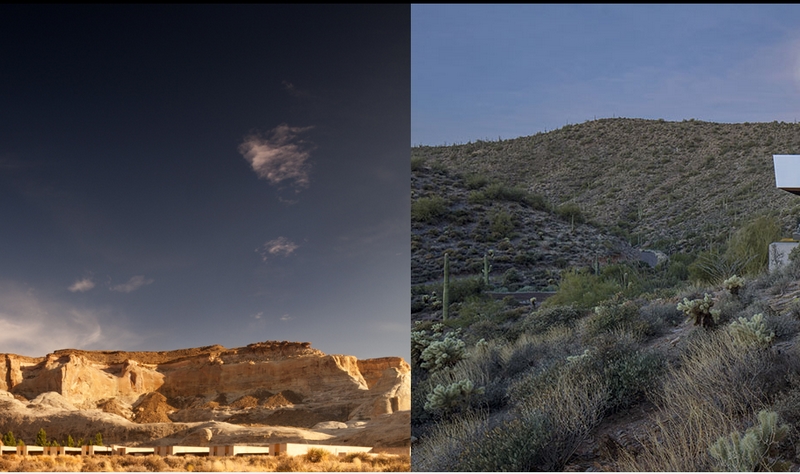Beloved by artists, mystics and hermits, the desert is a place for contemplation and coming face-to-face with oneself; a place to fully detox from the outside world and enjoy the purifying nothingness of a vast, barren, empty space. The desert retreats featured on these pages – the Glass Pavilion in Granada, Spain, and the Desert Courtyard House, the Desert Nomad House and the Levin Residence, all in Arizona – are an invitation to do just that.
These desert retreats are designed to help their inhabitants feel a sense of peace through connection to nature. Situation and design combine to turn the poetic idea of the idyll into reality.
Architects designing homes or retreats in remote locations, whether mountain, coast, lake, forest, river, plains or desert, may choose to evoke the sculptural and make their dwellings stand out against a canvas of land, sea or sky. But sometimes, in the desert, as elsewhere, the dwellings are carefully camouflaged, often at the owner’s behest in order to give nature its due supremacy, and they sometimes recycle earth, gravel or turf from the excavation of their plots. Many use local, natural materials, not only to reduce transportation costs and carbon footprint, but also to provide an organic sense of belonging to the terrain.

In these unique desert dwellings, the watchword is not abundance but lack, and this lack is embraced by those who want total escape. A stay in the desert is a chance to experience a wilderness that is sometimes brutal – only the hardiest plants and animals can survive here. Not for the faint-hearted, a desert retreat is the diametric opposite of a cosy rural escape.
The retreats featured here tap into the desert’s mythic status and possess an enigmatic quality. The vast blankness of the landscape provides an opportunity to practise serious abstraction: it is the perfect backdrop for bold, sculptural forms. Experiencing (and sometimes mitigating) the intense stimuli of desert immersion is the central idea behind many designs. The desert is harsh, and sometimes inhabitants need to withdraw into a protective shell. Interiors in these homes are cocooning, cave-like and cool – devoid of much fuss. Why bring endless stuff into the desert when the point of being there is to escape it all? These are not retreats for long stays, but are designed around sleeping, resting, meditating, cloud-watching and, of course, star-gazing.
With scant resources, desert retreats must be sustainable, using solar power and passive heating and cooling, and the remoteness of some locations means that prefabrication is essential. Aesthetic intentions range from careful camouflage to experiments in industrial homage.
Positioned to capture poetic moments – the way a mountainside reddens as the evening sun slides over it, or the first rays of dawn – many retreats here function as viewing apertures. The invitation is to arrive, switch off all distraction, and simply be, allowing your gaze to wander unchecked over the sublime emptiness.
Living on Vacation: Contemporary Houses For Tranquil Living is published by Phaidon at £29.95. Buy a copy for £25.76 from guardianbookshop.com
The Glass Pavilion

In Andalusia’s remote Gorafe desert, a simple, crystalline structure teeters on a plateau high above a valley pocked with scrubby grass and rocks. Dwarfed by a gigantic landscape, visitors can lie back to watch shooting stars streak through a night sky unspoiled by light pollution. Designed by Slovenian studio OFIS Arhitekti, the Glass Pavilion began as a project that aimed to prove that glass can be used as a fully structural element. The glazing features a near-invisible coating that prevents the interior from overheating. The Y-shaped structure rests on a mirrored wooden platform.
The Desert Courtyard House

Designed by Wendell Burnette Architects, this luxurious, monolithic courtyard house is located in the Sonoran Desert. The house is built from rammed earth, concrete, glass and weathered steel, merging land, house and sky. A glass-floored bridge gallery hovers over the earth so inhabitants get a sense of the natural world. Steps lead down on to a terrace and a narrow infinity pool that draws the eye towards a mountain peak beyond. The alchemy of water, rocks and cacti appeals to mind and senses.
The Desert Nomad House

Concealed within a forest of saguaro cacti in Arizona’s Tucson Mountains, the Desert Nomad House (Studio Rick Joy) is a cluster of three cuboid dwellings, each with its own function: sleeping, working, and relaxing. The rusted-steel boxes huddle within a natural bowl-like formation at the foot of the Tucson Mountains. Each one is arranged perfectly to give a ‘single aperture’ view of the desert landscape. The steel-plate exteriors glow burnt sienna in the setting sun and pick up rust-hued tones in the desert earth. Inside, the home is clad in warm, natural maple veneer and dotted with objets d’art.
Levin Residence

Designed by Ibarra Rosano Design Architects, the Levin Residence in Marana, Arizona, cantilevers over a sloping terrain, providing shelter for desert animals beneath the house. The home surrounds a courtyard with a pool and a deck with a freestanding black framework, which further focuses the views.
guardian.co.uk © Guardian News & Media Limited 2010
Published via the Guardian News Feed plugin for WordPress.


